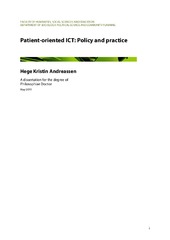| dc.contributor.advisor | Anderssen, Jorid | |
| dc.contributor.author | Andreassen, Hege Kristin | |
| dc.date.accessioned | 2011-10-05T09:34:09Z | |
| dc.date.available | 2011-10-05T09:34:09Z | |
| dc.date.issued | 2011-10-21 | |
| dc.description.abstract | The development of ICT aiming at patient users is a prioritised area in health care. This thesis investigates the policy background for this development, and on the changes that take place when health ICT is introduced to patients. The research draws on a document study from the health ICT sector and on two case studies where an electronic communication tool was introduced in doctor – patient communication. The findings indicate a discrepancy between expected and actual changes: patients’ use of ICT in everyday practice is more varied than the dominant conceptual models of the patient – ICT relationship take into account. Policies express expectations of health ICTs to function as riverbeds of information and thus contribute to realise contemporary ideals of patient involvement and new public management. In everyday practice, however, patients also relate to technology as security alarms, as shields to the pathologising of everyday life, as tokens of competence, and as symbolic attention from the health care system. Patient-oriented ICT matters to contemporary performances of health and of the patient. The technology does more than is expected of it, and opens for a new flexibility in patients’ relationship to health professional advice and care. | en |
| dc.description.doctoraltype | ph.d. | en |
| dc.description.popularabstract | Pasienter bruker i økende grad informasjons og kommunikasjonsteknologi (IKT) i sin samhandling med helsevesenet. Hva er bakgrunnen for denne utviklingen, og hvordan endrer den pasientenes hverdag?
I løpet av de siste tiårene har IKT blitt en del av hverdagen, også i helsesektoren. I PhD avhandlingen ”Patient-oriented ICT: Policy and practice” diskuteres innføringen av IKT i samhandling mellom pasienter og helsevesen. Det sosiologiske forskningsspørsmålet er om IKT får betydning for hvordan vi utfører helse og pasientroller i dagens samfunn. Avhandlingen bygger på én dokumentstudie, og to case-studier der en elektronisk løsning (lik e-post) ble innført i lege-pasient kommunikasjon.
Funnene viser at det ikke alltid er samsvar mellom forventede endringer og faktiske endringer når samhandlingsteknologi blir innført. I profesjonelle og politiske diskusjoner vektlegges det at pasientrettet IKT kan fungere som en kanal for informasjon til og fra pasientene. Derigjennom tenkes IKT å kunne bidra til å realisere helsepolitiske idealer om involvering av pasienten og ”new public management” i helsesektoren. I hverdagen forholder imidlertid pasienter seg til IKT på flere måter. Teknologien fungerer ikke bare som informasjonskanal, men også som sikkerhetsline, skjold mot sykeliggjøring av hverdagslivet, og som symbol på individuell helsekompetanse og oppmerksomhet fra helsesektoren. Når IKT innføres i samhandling mellom pasienter og helsevesen skjer det dermed mange ting på en gang. Teknologien åpner for endringer og den bidrar til fleksibilitet i pasienters forhold til helsevesenet. | en |
| dc.description.sponsorship | Helse Nord RHF | en |
| dc.description | The papers of this thesis are not available in Munin: <br/>1. Andreassen, H. K., & Trondsen, M.: 'Pasient på e-post (Patient on e-mail)', in Aksel Tjora (edt): Den moderne pasienten (The modern patient)(2008). Oslo: Gyldendal Norsk Forlag. <br/>2. Andreassen, H. K., & Trondsen, M.: 'The empowered patient and the sociologist', Social Theory and Health (2010), 8(3), 280-287. Available at <a href=http://dx.doi.org/10.1057/sth.2010.9>http:/dx.doi.org/10.1057/sth.2010.9</a> <br/>3. Andreassen, H. K.: 'What does an e-mail address add? Doing health and technology at home', Social Science and Medicine (2011), 72(4), 521-528. Available at <a href=http://dx.doi.org/10.1016/j.socscimed.2010.11.026>http://dx.doi.org/10.1016/j.socscimed.2010.11.026</a> <br/>4. Andreassen, H. K.: 'E-health is the solution; what is the problem?' (submitted manuscript to Health Policy). <br/>5. Andreassen, H. K. & Dyb, K.: 'Differences and inequalities in health – empirical reflections on telemedicine and politics', Information, Communication and Society (2010), 13(7), 957-975. Available at <a href=http://dx.doi.org/10.1080/1369118X.2010.499953>http://dx.doi.org/10.1080/1369118X.2010.499953</a> | en |
| dc.identifier.uri | https://hdl.handle.net/10037/3637 | |
| dc.identifier.urn | URN:NBN:no-uit_munin_3353 | |
| dc.language.iso | eng | en |
| dc.publisher | Universitetet i Tromsø | en |
| dc.publisher | University of Tromsø | en |
| dc.rights.accessRights | openAccess | |
| dc.rights.holder | Copyright 2011 The Author(s) | |
| dc.rights.uri | https://creativecommons.org/licenses/by-nc-sa/3.0 | en_US |
| dc.rights | Attribution-NonCommercial-ShareAlike 3.0 Unported (CC BY-NC-SA 3.0) | en_US |
| dc.subject | VDP::Samfunnsvitenskap: 200::Sosiologi: 220 | en |
| dc.subject | VDP::Social science: 200::Sociology: 220 | en |
| dc.title | Patient-oriented ICT : Policy and practice | en |
| dc.type | Doctoral thesis | en |
| dc.type | Doktorgradsavhandling | en |


 English
English norsk
norsk
